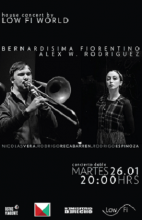Improvising Global Connection in Santiago, Chile

On January 26, my fieldwork in Santiago, Chile took an unforgettable turn when I took to the patio of a shared artists’ house to perform a set of improvised music with three Chilean jazz musicians. This concert came about as part of a transnational collective effort among Chilean jazz aficionados, a Danish web startup company, and my own network of family, friends, and fellow music lovers. By telling the story of this event, I aim to direct attention towards the ways in which people making music today can forge global connections and alternative social possibilities. I have included a recording of one song from the performance below; feel free to listen as you read its origin story below:
When I first arrived to Santiago in late September to begin an eight-month stint of fieldwork research, one of the first groups that I heard was the duo Peregrinos, which consists of drummer Rodrigo Recabarren and guitarist Raimundo Santander. Impressed by their music, I invited Recabarren to talk over coffee about his work as a transnational jazz artist—when we met the following week, I learned that he would be returning in December as part of Israeli guitarist Rotem Sivan’s jazz trio, and was looking to book an additional performance during their week in Santiago. I was familiar with the new Danish startup low-fi.world, having met founder Anne Dvinge at a jazz studies conference in 2014. Sivan’s upcoming tour seemed like a perfect opportunity for low-fi to pilot an event in Chile. Two young local musicians, vocalist Bernardita Fiorentino and guitarist Tomas Gubbins, organized the event in the home of Gubbins’s family. Another couple, Ana Maria Lara and Diego Pequeño, offered to video-record the concert. This first event took place in December 2015, and attracted about 20 people, mostly Chilean jazz fans and patrons of the small but vibrant local jazz scene.
Recabarren expressed a good deal of enthusiasm about the concert in our interview the following week, and put me in touch with Fiorentino to talk about possible next steps. She was in the midst of preparing for her first performance at the jazz club Thelonious at the end of the month, with Recabarren and two other musicians—guitarist Nicolas Vera and bassist Rodrigo Espinoza—with whom I had played during my brief trip to Chile in 2013. We decided to arrange a double-bill concert with each of us playing one set backed by this trio, one night before her performance.
Financing the concert was the main challenge that we faced in preparing this event. We agreed that paying the artists fairly was a primary concern; whereas the first concert had been generously underwritten by low-fi.world, this would have to be self-financed. However, we did not want to set high ticket prices, because we knew that would mean that some people who would otherwise be interested in attending would choose not to. We decided on a somewhat unorthodox experiment to resolve this dilemma: concert attendees were asked to contribute whatever they could to support the music, with a suggested donation of CLP$10,000 (about US$15). We raised the rest of the money by selling tickets to “be there in spirit” through the low-fi online platform for US$15 apiece. Those who purchased tickets would have a live recording sent to them after the concert, and their names read aloud during the concert—which means the recording would include recognition of their generosity and presence “in spirit.”
Fiorentino found the space, which was the private home of a group of her artist friends in the Providencia neighborhood of Santiago. We began to publicize the concert in mid-January, and ended up selling 41 tickets to 25 people—many people generously purchased multiple tickets to support the event. About 20 people attended the event live; all told, nearly 70 people from across the Americas and Europe were present—in body, spirit, or both—for a cool summer evening of musical improvisation in Santiago, Chile.
The week leading up to the performance was stressful, to say the least. In addition to managing the complicated logistics of the concert, I had to prepare the music! This was my first public performance in Chile since 2013, and although I had been practicing regularly since my arrival and attending weekly jam sessions at Thelonious, my distance from the regular work of musical performance left me feeling exposed. As an antidote to this anxiety, I drew inspiration from Ornette Coleman, whose music the quartet would be performing for much of the set. It is, after all, Coleman’s confident vulnerability that makes the music so exciting. Furthermore, I knew that I would be performing for friends, family, and a few hip Chileans—not for some abstract, critical audience—so I felt eager anticipation in the mix, as well. Still, the quick entry in my fieldwork journal from that day begins, “Performance tonight! Nervous!”
Rehearsal time was another limiting factor for this performance—because these musicians are all first-call players locally, we were only able to secure an hour-long dress rehearsal to rehearse with the full band. I had sent the set list and recordings out to the group in advance, and had to trust that they would listen. On the day of the event, it proved just enough time to coordinate entrances, solos, and endings. The set list was as follows:
Song Title | Composer | Instrumentation |
Turnaround | Ornette Coleman | Quartet: tbn/bass/gtr/drums |
Sleep Talk | “ | “ |
Law Years | “ | “ |
Peace | " | “ |
Schoenberg Jr. High | Alex W. Rodriguez | “ |
Peñaflor | “ | “ |
We Travel the Spaceways | Sun Ra | Quartet + vocals (Fiorentino) |
Once the performance began, the experience was that of a constant tug-of-war between a hyper-sensitive self-critical impulse and another voice, which seemed to be trying to always remind me to come back to reality and listen to the present moment. I have a habit of ruthless self-critique when it comes to my own musical performances allowing the experiences of momentary doubt to stick in my memory the most. But the two pieces I wrote for the concert were inspired by Coleman’s harmolodic approach, and thus the improvisational framework was quite open throughout the evening. This allowed for that other voice—that of the non-judgmental listener—to have a say as well. The three other musicians had varying degrees of experience with harmolodic improvisation but their jazz training served them well—I remember feeling buoyed by the groove, and although there were some occasional clashes, they folded themselves well into the adventure.
When I could let go of that nervous self-critique and bring awareness to my experience of any given moment, I was overcome by the co-presence of everyone involved. By taking center stage, this seemed to reflect my position as a node that connected these 70-some-odd human beings scattered across the planet. I felt the slide of my trombone moving; I felt the limitations of my technical training in the upper register, or when I felt myself attempting to execute musical ideas that were beyond my degree of preparation; I felt the subtle and generative resistance of the trombone resonating at a slightly discrepant frequency from what I heard in my head; I felt my feet on the ground, and a sturdy posture rooted in those two feet. Within that, I saw flashes of imagery and heard bursts of timbre that evoked the people I knew who were attending. This culminated in a very powerful experience on the final song, Sun Ra’s “We Travel Spaceways.” Partway through, I instructed the audience to perform the basic instruction of Pauline Oliveros’s “Human Tuning” exercise, and their collective voices carried some part of my consciousness upwards, out of my body, and slightly behind me. For that moment, I felt the connectivity to all of those people—including those there “in spirit”—and the only analogy that I seem to be able to express in writing is that it felt like looking at a distant image of the Earth, like the famous “pale blue dot” photo taken by the Voyager 1 spacecraft:

View of Earth from 6 billion km. The planet appears as a small speck in the brown band on the right
"We Travel the Spaceways" by Sun Ra with "Human Tuning" by Pauline Oliveros
Afterwards, I took in Fiorentino's second set from the crowd, and enjoyed her original compositions and eccentric cover versions of jazz classics. I woke up late the following morning, completely exhausted, only managing to get out of the apartment late in the evening to hear her encore performance at Thelonious. The exhilaration from the experience of the previous night, and that glimpse of the pale blue dot, drained my body but blew my mind. In the three weeks since the concert, it has been very difficult to muster the energy and clarity to write about the experience. The only words I was able to wrestle onto paper the day after was the following note in my fieldwork journal: “I have so much more to say about last night, but I’m almost too tired to think!”
Putting on this concert was the culmination of a long process of creativity, exploration, and global connection that led to a powerful felt sense of our collective humanity. Given the paucity of ethical ways for musicians and listeners to interact musically at a global scale, I am heartened by the playfulness, enthusiasm, and collective effort that surrounded this project because together we managed to bring an alternative into being—at least for one night. This project prioritized the fair compensation of performing musicians. It emphasized global connection through activating a network of geographically diverse participants through digital tools. And we used the recording as a way of being there in spirit together, across time and space but sharing a collective sense of global scale.
Reimagining the recording as an extension of co-presence, rather than a circulating commodity, is a way of using the medium to reinforce global connections while resisting the terms upon which “music” is made within global capitalist infrastructure. It also emphasizes, for me, the tremendous challenge of bringing alternative ways of making music into the world; it certainly deepened my respect for the many pioneering space-makers throughout jazz history who have done so—as well as those who continue to do this work around the world. For example, NPR’s Jazz Night in America recently profiled one such group in Washington, DC:
I am optimistic that experimental music-making along these lines can mean something in the 21st century, as a way of imagining generative alternatives to the challenging status quo of global-scale cultural production. Through an improvised and experimental social ethos and the crucial lineage of African-American creative improvised music, the surprising confluences of activity that bubbled up in Santiago earlier this year can also thrive elsewhere—and I hope to be there listening (at least in spirit) when they do.
The author would like to thank all of the generous individuals who participated in this event, especially Bernardita Fiorentino, Tomas Gubbins, Ana María Lara, Diego Pequeño, Anne Dvinge, Rodrigo Recabarren, Nicolás Vera, Rodrigo Espinoza, Ornette Coleman, Sun Ra, and Marina Kantarovich Rodriguez.





